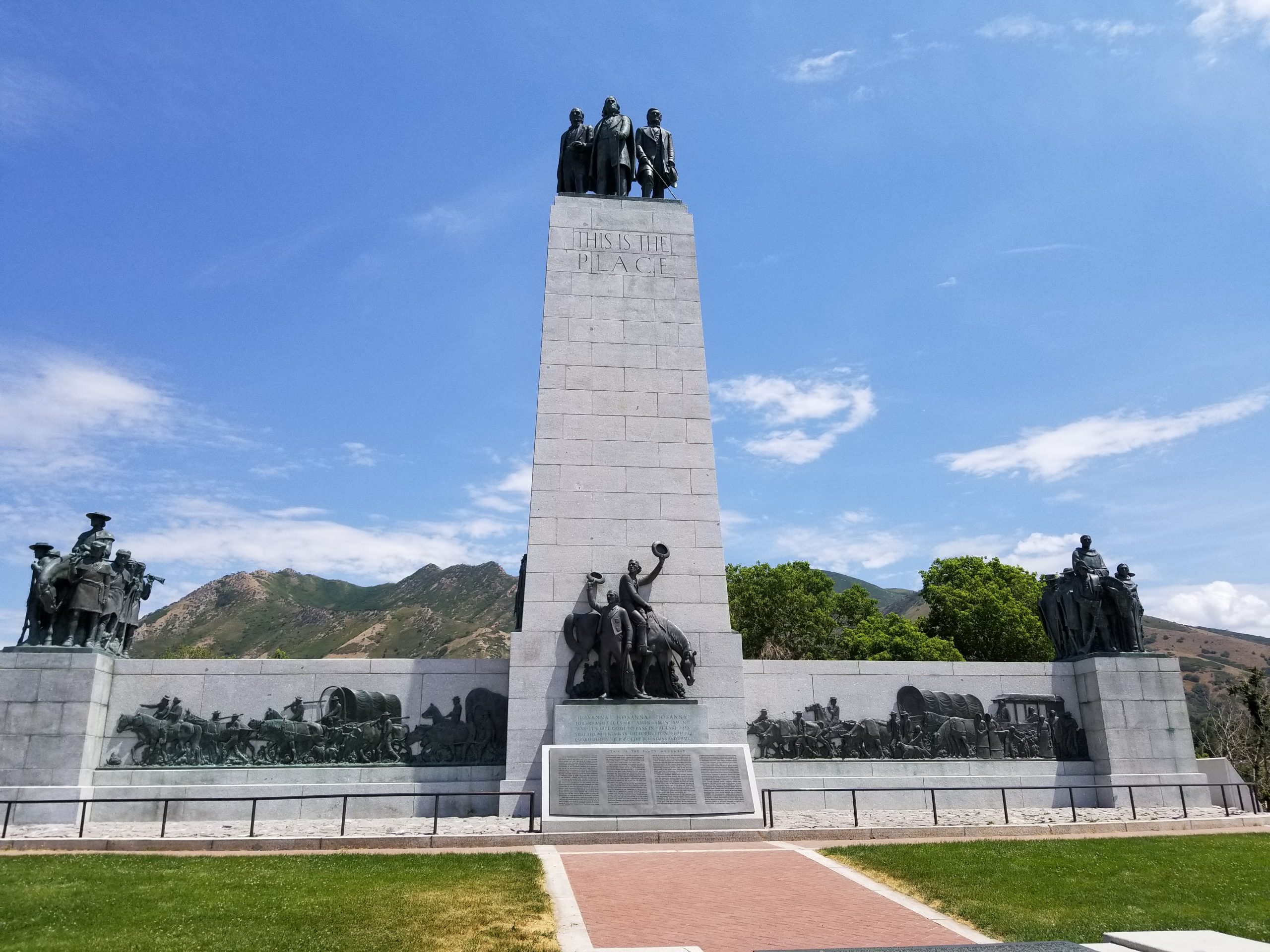Write Up by Aaron Ika
Placed by: Daughters of Utah Pioneers, No. 56, January 1940
GPS Coordinates: 40° 31′21′′ N, 111° 51′56′′ W
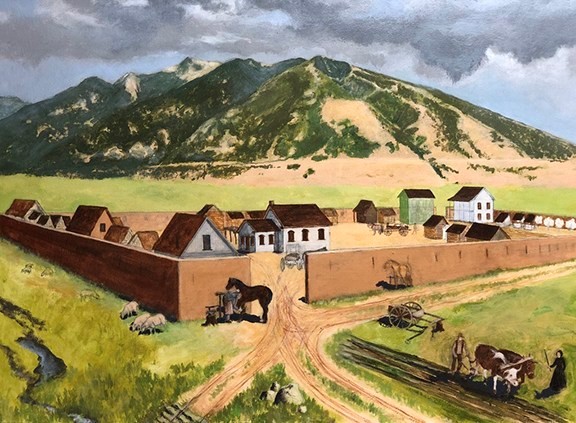
Historical Marker Text:
ERECTED JANUARY 1940
“OLD MEETING HOUSE” DRAPER FORT
THE NORTH WALL OF THE “OLD MEETING HOUSE’ STOOD NEAR THIS MONUMENT. HERE (1861-1869) DR. JOHN R. PARK BEGAN HIS CAREER AS AN EDUCATOR IN UTAH. THIS SCHOOL PRODUCED MANY OF THE STATES LEADERS AND LEFT AN INDENIBLE LOVE FOR THE EDUCATION IN DRAPER.
THE GRANITE BLOCK IN THIS MONUMENT WAS THE SOUTH STEP OF THE OLD CHURCH. THIS SPOT WAS WITHIN THE ENCLOSURE OF THE OLD ADOBE FORT 184 YDS. X 113 YDS. THE WALL WAS 14 FT. HIGH AND 3 FT. THICK.
EBENEZER BROWN CAMP
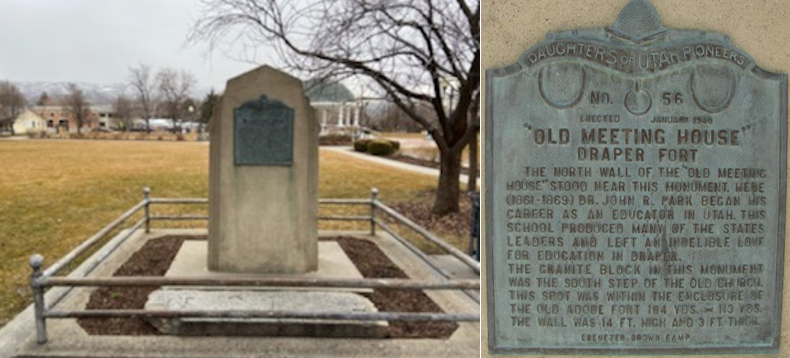
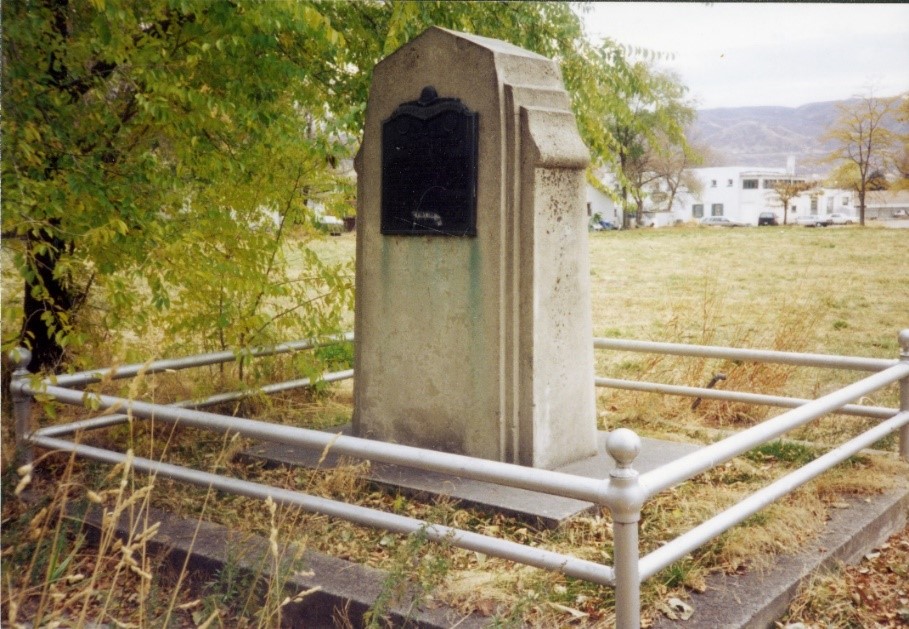
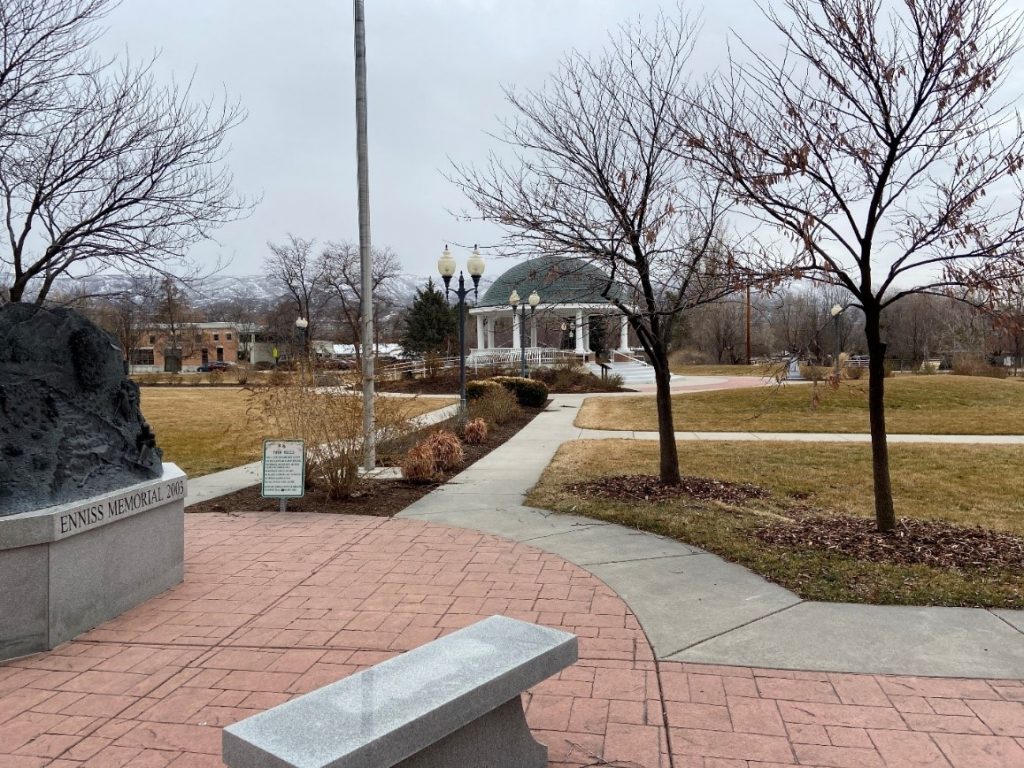
Extended Research:
The marker for the Old Meeting House Draper Fort commemorates two important pieces of history in Utah and the city of Draper: the Draper Fort and the Old Meetinghouse that sat inside the fort. The marker is located on the north side of Draper Historic Park.
Settlers moved to the south east end of the Salt Lake Valley into an area called South Willow Creek in 1850. The area grew rapidly and by the end of 1852, 20 families called South Willow Creek home.[1] In 1854, the establishment of the first post office brought a name change to the town. The area came to be known as Draperville, in honor of William Draper JR, who was a prominent member of the Church of Jesus Christ of Latter-day Saints (LDS). In 1877, the town shortened the name to Draper.[2]
On 10 April 1854, Brigham Young addressed the followers of his church: “from hence forth, let one and all go forth with one accord and build their forts, wall in their cities and villages, herd and guard their cattle and other property and keep their guns and ammunition in good order and convenience, ready for instant use.”[3] Skirmishes erupted from Sanpete to Salt Lake Counties between Native Americans under Ute Chief Walkara and settlers. Walkara had become upset by Mormon efforts to stifle Indian slave trading and by the increased intrusion of settlers into traditional Native American hunting grounds.[4] This broader violence shaped the first Mormon settlement in the area that became Draper.
Ebenezer Brown and his family were the first settlers to arrive in “South Willow Creek” in 1849. Ebenezer’s homestead was 160 acres. Because of the Native threat, and at Brigham Young’s directive, Ebenezer donated 5 acres of his property to build a fort where members of the community could gather and feel safe. In late 1854, the fort construction began for protection to those pioneers homesteading in the area. It took two years to build walls of adobe brick and clay around the fort that measured 23 rods east to west and 35 rods north to south. A Rod is an old English measure of distance equal to 16.5 feet (5.029 meters). The walls were eight feet high and one foot wide with look-out slots every fourteen feet. All homes faced the center of the fort.[5]
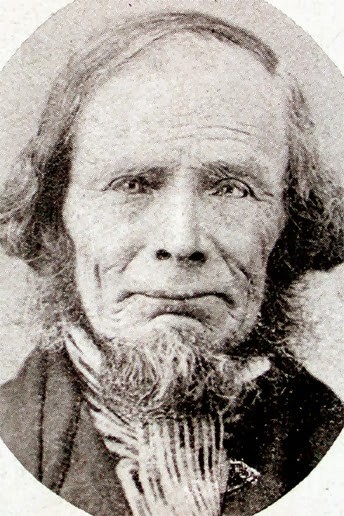
The Draper Historical Society has researched the fort extensively and created a map of houses and shop locations inside the fort.
The entrance to the fort was a dirt road through a wide opening in the northwest corner of the fort and in front of Lauritz Smith’s blacksmith shop. A garden area was at the southwest end of the fort. It included a small orchard of apple and peach trees, planted by William Terry with seeds he carried across the plains from Rhode Island. John Fitzgerald’s home was built on the northeast corner of the fort. John’s mother, Ann, had a candy store attached to the home. The first house built was Ebenezer’s, and then running west along the south wall were three other small homes. Perry Fitzgerald’s two-story home was built on the east wall and to the west was the LDS Church tithing office and granary and the Relief Society Hall. Ebenezer’s son, Norman Brown, built an adobe brick house. This house also served as Draper’s first schoolhouse. From its beginning, Draper showed a special interest in education. Schooling began right away with Betsy Draper, wife of William Draper, as Draper's first teacher. Town leaders were always on the lookout for qualified teachers and paid them out of their own pockets. By the year 1855 the population of the community had grown to 222 people. Up until then church, school and public meetings were held in homes. More space was needed, so in 1860 the vestry was built across from the Norman Brown home. In 1863 the main hall was added to the vestry, and from that time the building was known as "The Old White Meetinghouse".[6]
The fort was an essential part of the community and provided the settlers with a sense of security and comfort during the early history of Draper.[7] Due to the increased tensions with the Native Americans and the settlers, many people tended to things outside the fort during the day such as their own homes, cows, sheep and other livestock. At night they returned to the fort to be safe from home raids. The temporary homes inside the fort were for sleeping only. They were very small with some being just one room. Some were no larger than a wagon box. Difficulties with Native American tribes lessened by the late 1850’s. The fort was never attacked, and families began returning to their homes. Ebenezer Brown deeded the “center area” of the fort to the community.[8] The fort was disbanded around 1864 and the fort walls were gradually dismantled. The Old White Meetinghouse and some of the original homes remained and in 1892 the Draper First Ward Church was built on the property.[9]
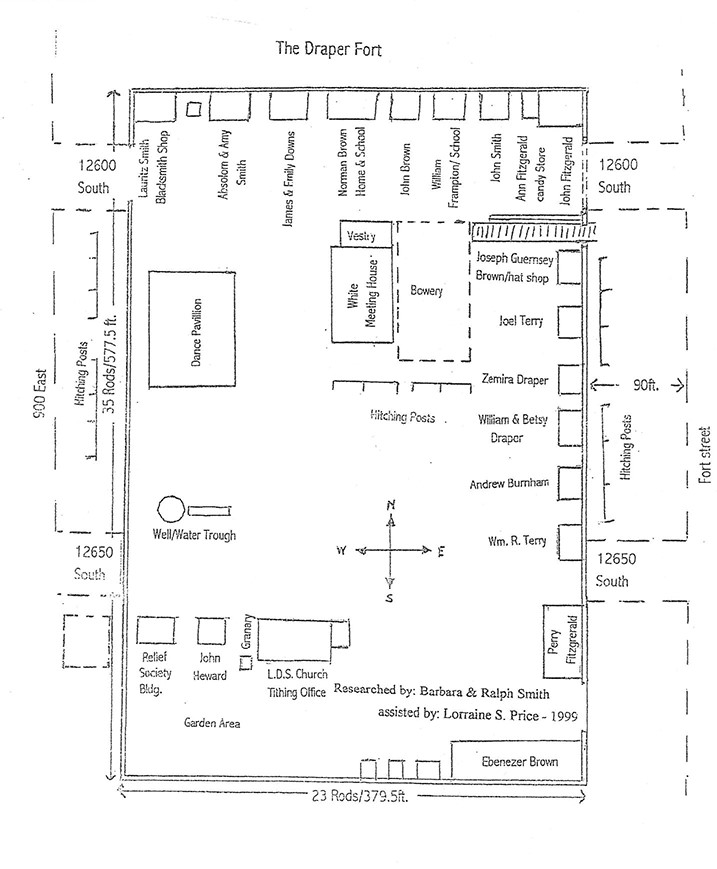
The Draper Fort housed one of the town’s most essential buildings, the schoolhouse. Settlers of Draper built the first schoolhouse in 1852 on the north wall of the Draper Fort.[10] The schoolhouse became home to early educator, John Rocky Park. The schoolhouse also served as a public and spiritual gathering place for nearly twenty years after construction.[11] Park was an integral figure in education in not just Utah but in the expansion of the western territories of the United States. Park was at one time, president of the University of Deseret, that was later renamed the University of Utah. In 1895, Park was elected as Utah Superintendent of Education.[12]
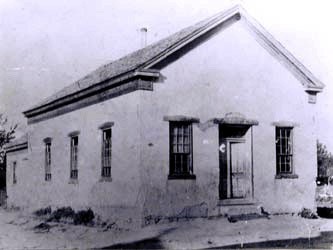
Draper became known as the “Cradle of Education” in the West.[13] The Draper curriculum of John Rocky Park became known for its excellence at all grade levels. Park gained notoriety for his school and what was being taught inside its walls. With Trustee funding, Dr. Park, provided blackboards, maps and charts.[14] Brigham Young even wanted to build the University in Draper but disputes over land caused the site to move locations.[15] A student of those days reminisced: “The [school’s] walls were soon covered with maps and charts illustrative of all departments of knowledge. Models and globes rested on the broad window seats. A tellurion, a miniature illustration of the planetary system, was provided . . .”[16] Author Ralph Chamberlain found evidence of the renowned success of John R. Park’s school in Draper: “From a little country village, with a population of about 300, secluded in a corner of the Salt Lake Valley, in a brief period of five years that still stands out as its golden age, went forth a surprising number of men who later achieved high success; and in that village developed a spirit and movement that in time spread beyond it and inaugurated in Utah an educational regeneration. Never was the potential power of the good teacher more strikingly demonstrated.”[17]
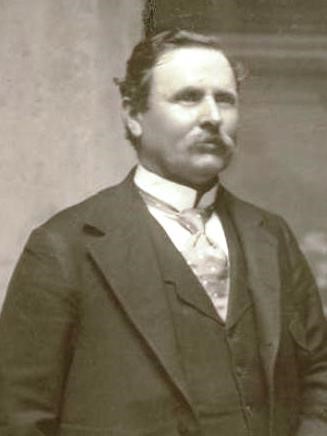
In January 1940, the Ebenezer Brown Camp of the Daughters of the Utah Pioneers erected a monument on the original site of the old meetinghouse. The granite block in the monument was the south step of the old church.[18]
For Further Reference:
Primary Sources:
James Herman Tegan, “Pioneer Personal History” Survey, The Works Progress Administration (Utah Section) Biographical Sketches, 1939, https://collections.lib.utah.edu/ark:/87278/s6pv8qj7
John Hamilton Morgan, “Scans of miscellaneous papers related to John Hamilton Morgan”, Digitized by J. Willard Marriott Library, University of Utah, 1951-1952, https:/collections.lib.utah.edu/ark:/87278/s6dn4xjn
John R. Park papers, MS 0242, Box [ ]. Special Collections and Archives. University of Utah, J. Willard Marriott. Salt Lake City, Utah.
Elisabeth Boulter Enniss, Journal 1874 – 1879, Draper Historical Society Museum, Draper, Utah
Secondary Sources:
PETERSON, CHARLES S. “A New Community: Mormon Teachers and the Separation of Church and State in Utah’s Territorial Schools.” Utah Historical Quarterly 48, no. 3 (Summer 1980): 293-312.
Willey, Darrell S. “Utah’s Frontier Architect of Social Destiny: John R. Park.” Peabody Journal of Education 38, no. 2 (1960): 100-06.
Noel Ennis, True to the Faith: The Life of W.B. Enniss 1857-1947, (Pioneer Books, 2004)
Draper Historical Society, “The History of Draper, Utah, vol. 2: Sivogah to Draper City 1849-1977”, (Agreka Books 2001)
Draper Historic Preservation Commission, “Draper History,” Draper Utah’s Historic Buildings, May 19, 2017, accessed April 2, 2020
Draper Historic Preservation Commission, “Draper Park School,” Places that Matter – Draper, Utah, May 2014, accessed April 2, 2020
University of Utah, and Ralph V. Chamberlin. 1949. Memories of John Rockey Park
Footnotes:
[1] Draper Historical Society, “The History of Draper, Utah, vol. 2: Sivogah to Draper City 1849-1977”, (Agreka Books 2001)
[2] Noel Ennis, True to the Faith: The Life of W.B. Enniss 1857-1947, (Pioneer Books, 2004)
[3] Draper Historic Preservation Commission, “Draper History,” Draper Utah’s Historic Buildings, May 19, 2017, accessed April 2, 2020
[4] University of Utah, and Ralph V. Chamberlin. 1949. Memories of John Rockey Park
[5] Draper Historic Preservation Commission, “Draper History,” Draper Utah’s Historic Buildings, May 19, 2017, accessed April 2, 2020
[6] Draper Historic Preservation Commission, “Draper History,” Draper Utah’s Historic Buildings, May 19, 2017, accessed April 2, 2020
[7] Draper Historic Preservation Commission, “Draper Park School,” Places that Matter – Draper, Utah, May 2014, accessed April 2, 2020
[8] Draper Historic Preservation Commission, “Draper History,” Draper Utah’s Historic Buildings, May 19, 2017, accessed April 2, 2020
[9] Draper Historical Society, “The History of Draper, Utah, vol. 2: Sivogah to Draper City 1849-1977”, (Agreka Books 2001)
[10] John R. Park papers, MS 0242, Box [ ]. Special Collections and Archives. University of Utah, J. Willard Marriott. Salt Lake City, Utah.
[11] John R. Park papers, MS 0242, Box [ ]. Special Collections and Archives. University of Utah, J. Willard Marriott. Salt Lake City, Utah.
[12] University of Utah, and Ralph V. Chamberlin. 1949. Memories of John Rockey Park
[13] University of Utah, and Ralph V. Chamberlin. 1949. Memories of John Rockey Park
[14] PETERSON, CHARLES S. “A New Community: Mormon Teachers and the Separation of Church and State in Utah’s Territorial Schools.” Utah Historical Quarterly 48, no. 3 (Summer 1980): 293-312.
[15] Draper Historic Preservation Commission, “Draper Park School,” Places that Matter – Draper, Utah, May 2014, accessed April 2, 2020
[16] Elisabeth Boulter Enniss, Journal 1874 – 1879, Draper Historical Society Museum, Draper, Utah
[17] University of Utah, and Ralph V. Chamberlin. 1949. Memories of John Rockey Park
[18] Draper Historic Preservation Commission, “Draper History,” Draper Utah’s Historic Buildings, May 19, 2017, accessed April 2, 2020
